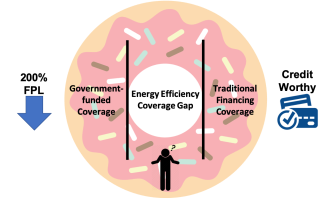Our recently published study estimated that about 1 in 8 Michigan households fall into an energy efficiency funding coverage gap.

Access to upfront capital remains a primary barrier to many households making energy efficiency improvements to their homes. While government-funded programs, such as the Department of Energy’s Weatherization Assistance Program, exist for low-income households (typically those <200% FPL), and traditional loans and other financing services are available for creditworthy households; households that do not meet either of these criteria find themselves in an energy efficiency funding “donut hole,” unable to make critical energy-saving upgrades.
Authors, Sydney Forrester and Tony Reames, partnered with Michigan’s green bank, Michigan Saves, to explore statistics from approximately 12,000 green bank loan applications and the US Census Bureau to estimate the energy efficiency funding coverage gap across the state’s 83 counties. Statewide, an estimated 12%, or nearly 460,000 households fall into the energy efficiency funding coverage gap, while that percentage ranges from 0% to 24% of households across individual counties, as seen in the images below. Figure A (on the left) illustrates the number of households in the gap in each county, while Figure B (on the right) illustrates the percentage of households in the gap in each county.

Understanding the market potential and spatial distribution of the energy efficiency funding coverage gap allows for impact-driven financiers such as green banks or community development financial institutions (CDFIs) to expand their programming to this under-served market which can promote energy system improvements, facilitate multi-level policy goals, improve household living conditions, and achieve an equitable clean energy transition.
This month, Michigan Governor Gretchen Whitmer proposed a $5 million appropriation to Michigan Saves, the nation’s first nonprofit green bank, in her 2021 budget intended “to leverage private investment in clean energy improvements for Michigan’s residents and businesses.” If approved, this funding could begin to fill the energy efficiency funding coverage gap.
This study was funded by the Alfred P. Sloan Foundation and published in the journal Applied Energy in February 2020. A special thanks to Mary Templeton and Todd Parker who served as very helpful research partners.
Read the published paper here.


2 thoughts on “Study finds an energy efficiency funding coverage gap exists in Michigan”